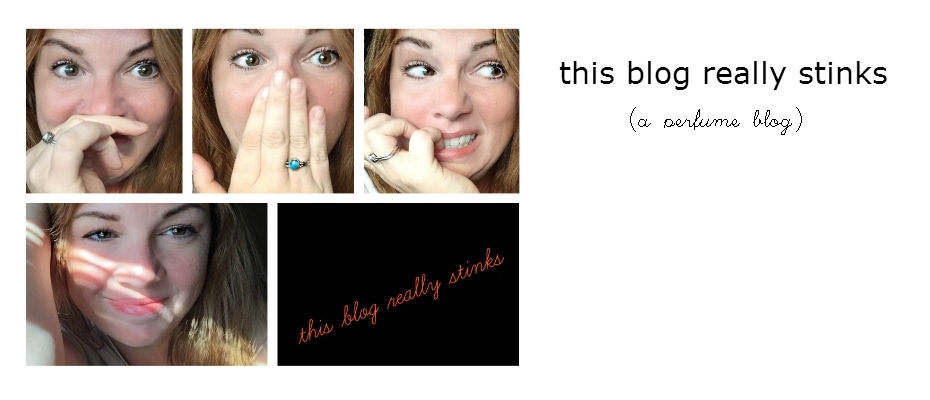This blending of perfume and paint is nothing out of the ordinary for Ms. Hurwitz (aka "DSH"), herself a painter and jeweler in addition to being a world class perfumer. DSH paints in "my style"*, a version of Abstract Expressionism**. The style is often a visual expression of thoughts or feelings without much -if any- figurative representation. The style is loose, maybe primal, often intense, highly subjective for the viewer and, by definition, emotional. Does that sound to any of us like perfume?
So for DSH, the art-perfume connection is strong. It was probably natural for this collaboration between her and the Denver Art Museum to come about.
*Yeah, I paint sometimes. I love it.
I wish I had time, money and space to do more!
**Think Mark Rothko, Jackson Pollock,
Robert Motherwell, Willem de Kooning,
Helen Frankenthaler.
Those are some of my favorites,
but there were many whose work
is considered "Abstract Expressionism".
I wish I had time, money and space to do more!
**Think Mark Rothko, Jackson Pollock,
Robert Motherwell, Willem de Kooning,
Helen Frankenthaler.
Those are some of my favorites,
but there were many whose work
is considered "Abstract Expressionism".
"It is far better to capture the glorious spirit
of the sea than to paint all of its tiny ripples."
of the sea than to paint all of its tiny ripples."
- Jay Meuser, Abstract Expressionist
 |
| Denver Art Museum |
Cities of Splendor
Cities of Splendor, the art exhibit, focused on the Italian Renaissance (15th and 16th centuries) and explored the styles specific to various regions of the country. Your time to view the exhibit is over, unfortunately, but the scents live on (as do the paintings, of course - just not all in one room at the moment!).
Italian Splendor, the perfume collection, brought "the glory and richness of the greatest cities and art of Italian Renaissance to life in fragrant form." [via the DSH website]
“We want to transport our visitors to Renaissance Italy, where cities such as Florence, Venice, and Milan played a major role in the development of this innovative, artistic style,” says curator Angelica Daneo. “During the 1400s and 1500s, Italy was not a unified country, but rather a group of independent states with different characters and artistic traditions. The exhibition will show how local styles merged with the innovative ideas coming from Tuscany, and resulted in distinctive styles and lasting examples of Renaissance art.”
Italian Splendor[via Denver Art Museum]
Italian Splendor, the perfume collection, brought "the glory and richness of the greatest cities and art of Italian Renaissance to life in fragrant form." [via the DSH website]
There are six perfumes representing six Italian cities or areas:
- Alba - "from across the Alps"
- Adoration - from Milan
- Divine Gardens - Mantua
- Medici - Florence
- Secreti di Belle Donne - Venice
- Venus & Cupid - Siena
The Reviews
I have samples of all six of the Italian Splendor scents, which is where I'm getting that delight I mentioned at the top of this post. The frustration? I received these samples from DSH and almost immediately had them stolen from me. There is a special place in hell for perfume thieves, by the way. Dawn was sweet enough to send me a second pack of samples (thanks again, Dawn!) and I sampled them to review. And I wrote my reviews. And my computer -or Blogger?- ate my reviews. And I feel cursed! But the collection is amazing and so I am re-doing the whole shebang and, sadly, emptying my sample vials to do so.
[It's OK - Santa has my purchase order for Christmas! ;) ]
Here are the six scents and my impressions of them.
Each scent is accompanied by an image from the exhibit that Dawn chose to display with the scent.
- Alba ("from across the Alps)
Many wonderful works of Renaissance Art were created in Northern climes. Tapestries were known especially from the Flemish through France and into Italy. Alba was inspired by one such tapestry from the late 1500's, woven at a Brussels workshop. The tapestry is made of wool and silk and the fragrance has been designed to convey that subtle sense of texture. Alba also takes it's inspiration from alpine flowers, delicate flowering trees and a delicacy of the northern landscape, white truffle.
Top notes: Bergamot, Bitter Almond, Bitter Orange, Lemon, Petitgrain
Middle notes: Elderflower absolute, French Beeswax, Italian Neroli, Jasmine, Jonquil, Olive Flower,Orange Flower Absolute - Spain, Orris Concrete, White Rose Accord
Base notes: Australian Sandalwood, Heliotrope, Virginia Cedar, White Truffle
The first few minutes are stupendous, morphing from one thing to another - all beautifully blended and seamless.
Close attention allows me to pick out the lemon, the orange blossom, the jasmine and rose - but if my attention wavers for a moment I am refocused on a beautiful and gently swirling "floralocity". Slowly a slightly powdery nuance is folded in, gently - as if cooking the perfect mousse. The powder and florals continue to soften into a lovely and light woody-earthy drydown.
I can't imagine a better representation of tapestry work, by the way. The way the notes blend but somehow also remain intact, they way they make patterns - it's all very clever. I do not see colors with things I smell (synesthesia), but even I can realize that the scent matches beautifully with the soft greys and earthy colors in the tapestry shown. Alba wears fairly close and fades after about 3 hours, but that only means I get to put it on again and experience those amazing top notes!
- Adoration (Milan)

Bonaficio Bembo
active about 1444-78,
Adoration of the Magi,
about 1455-60,
tempera and oil paint on panel,
Denver Art Museum;
the Simon Guggenheim
Memorial Collection, 1957
167
Inspired by Bonifacio Bembo's "Adoration of the Magi" (about1455-1460) and Renaissance Milan's great wealth and status among cities. This fragrance depicts traditional Catholic incense, which is based on the gifts of the Magi to the Christ child: frankincense, gold and myrrh. Even during the Renaissance, these rare aromatic gifts of the East (frankincense and myrrh) were more costly than their weight in gold.
I have included a precious rose note to this design as well, to center the essence and to symbolize Mary.
Top notes: Angelica, Galbanum, Immortelle, Rosewood (bois de rose)
Middle notes: Bulgarian Rose Absolute, Eastern Lily, Red Rose
Base notes: Atlas Cedarwood, Australian Sandalwood, Frankincense co2 absolute, Labdanum No. 3, Myrrh Gum, Vanilla Absolute
Let me start by saying that as a former Catholic (12 years of Catholic school, Mass every weekend), I don't think of this as a church-y incense. At least, it's not church-y in the way that Armani Privé Bois d’Encens is. Boy, do I love that perfume! It's weird, though, because I don't really love the scent of an incense censer swinging down the aisle.
But Bois d'Encens is a BIG scent (with an even larger pricetag, by the way). This perfume, Adoration, is much quieter and more contemplative. It smells to me not of the burning incense during Mass, like Armani's scent, but rather of the church when no one is in it. It's the lingering scent of soft incense over the woods used to build the church and its pews. Soft florals hint at the perfumes of the women who bowed their heads while kneeling to pray and maybe even a breath of flowers from the arrangements on the alter.
This perfume is beautiful. It is one that helps me find my center, my place of calm. It has been a long, long time since I found comfort in the church - but this scent is my new comfort, my zen. It's perfect for soothing oneself after a bad day. It's a great sleep scent, too, though it's a shame to miss the drydown which is soft and floral and comforting with a dose vanilla and sandalwood to keep you nice and mellow. This would be a great thinking perfume, too, I suspect. I may grab it the next time I'm on the horns of a dilemma. It can't hurt.
- Divine Gardens (Matua)
Inspired by the allegorical image, "The Triumphs of Time, Fame and Divinity", by a follower of Andrea Mantagna, Divine Gardens not only speaks to the imagery in the work but also Mantua's exquisite homes and gardens of the wealthy and powerful.This green and glorious fragrance is my first green chypre utilizing a tomato leaf note.
Top notes: Bergamot, Bitter Orange, Green Mandarin, Spearmint, Sweet Basil, Tomato Leaf, White Thyme
Middle notes: Bulgarian Rose Otto, Grandiflorum Jasmine, Muguet (Lily of the Valley), Sylvestre Pine, Tagettes, Violet
Base notes: Australian Sandalwood, Balsam Fir, Brazilian Vetiver, East Indian Patchouli, Musk, Orris Root
This perfume urges me to walk in the woods, breathing in the scents of the trees and listening to the sounds of my footsteps.
Divine Gardens might be classified by some as "masculine" (I don't waste time on that nonsense). It certainly would be classified by most as "green". It's not galbanum-green, rather pine-and-herbs-green.
This perfume is clean, fresh and invigorating. It's also pretty linear on my skin (or to my nose). There's a lovely tomato-leaf note (I really love that in a perfume!) that runs throughout, though the herb-y top notes fade to pretty florals and eventually to a pine-y wood drydown. On me, this scent lasts for several hours and wears close to the skin with minimal sillage.
- Medici (Florence)
Natural
Follower of Sandro Botticelli
1445-1510
Portrait of a Young Man in a Red Cap
About 1481
Tempera on panel
Lent by the Berger
Collection Education Trust
TL-17328
One of the most famous names in Renaissance Italy, not only among the mighty, wealthy and powerful but also among the fashionable and beautifully scented. They were known as a lavishly scented clan. My Medici perfume was not only inspired by this fabulously scented family but by a painting attributed to a follower of Botticelli called "Portrait of a Young Man in a Red Cap". The scent speaks to fiery red spice notes, deep woods and leathers that would have been found in any study of a young Renaissance aristocrat.
Top notes: Bergamot, Black Pepper, Citron Accord, Rosewood (bois de rose), Sweet Orange
Middle notes: Artichoke, Carnation, Cinnamon Bark, Clove Bud, Green Peppercorn, Origanum, Red Rose, White Thyme
Base notes: Amber, Ambergris, Leather, Moss, Orris, Peru Balsam, Tobacco Absolute, Virginia Cedar
One isn't supposed to have favorites when it comes to kids or relatives, but with things like ice cream or shoes it's OK. It is also OK to have a favorite perfume from a collection. If it wasn't ok before, then let's make it so! And this scent, Medici, is my favorite from the Italian Splendor collection.
The Medici family were great patrons of the arts, and if they were "fashionable and beautifully scented" to boot, I'm a huge fan. Hold on - I'm going to use this as an excuse to douse myself in this perfume again so I can talk about it even more intelligently than usual. ;)
The top of Medici is fairly classic - lots of bergamot and bright citrus. It immediately takes a turn to an interesting, peppery and spicy place. There are a few spicy, biting herbs, peppercorns, cinnamon and clove all assaulting my nose in an almost edible way.
The florals are buried under these spices - in fact carnation likely adds to the feisty melange. The rose serves to flesh out the scent and add a lovely, classic beauty.
I'm not sure I would automatically think of this perfume as "red". Instead, it's the most lovely ruddy leather tone. Speaking of leather...
There's leather and oakmoss in this baby! And I swear there's incense in there - is it a olfactory trick?
Medici's drydown is heavenly, though not in the way that Adoration is (see above). Medici is a little dirty, very earthy, and quite sexy. I don't think it projects much off the skin, but it lasts and lasts and lasts. The far, far, far drydown is a soft amber with the occasional flicker of leather, embers that stir up from time to time before dying back down.
If you are a fan of classic perfumes, leather scents, or grand Perfumes like Amouage you'll likely love Medici.
- Secreti di Belle Donne (Venice)
During the Renaissance, Venice was at the height of it's power and luxury. Not only the global force for trade in Europe of exotic spices, fabrics and ships, but also for love and seduction through their beautiful Courtesans. A famous book of the period was called simply "Secreti"; a book of beauty secrets. My Secreti di Belle Donne perfume is inspired by the famous Courtesans of Venice and Venetian delicacies as well as the work by Vittore Carpaccio, "Portrait of a Lady with a Book".
Vittore Carpaccio
about 1465-1525
Portrait of a Lady with a Book
about 1495
oil on panel
Denver Art Museum
Gift of Samuel H. Kress Foundation
1961.168
Secreti di Belle Donne is a wonderfully rich and subtle perfume that speaks to the beauty preparations of the lovely ladies of Venice as well as the underlying erogenous scent of the lovers trysts.
Top notes: Bergamot, Bitter Orange, Blood Orange (Sicily), Cardamom co2 Absolute, Cured Fruit (accord), Melon
Middle notes: Cinnamon Bark, Clove Bud, Damask Rose Absolute, Orange Flower Absolute - Spain, Osmanthus, Saffron absolute, Sambac Jasmine, Ylang-Ylang
Base notes: Amber, Ambergris, Benzoin, Ciste Absolute, Civet, Honey Beeswax, Honey Musk, Vanilla Absolute
Secreti di Belle Donne is one of my absolute favorites from this collection.
Fresh on the skin, SdBD is a glorious honeyed fruit-creme with gentle spices. Ripe (over-ripe?) melon is tangled with citrus and fruit in a sensual, not terribly well-hidden metaphor for our young and luscious Belle Donne.
Almost immediately, that ciste absolute jumps in and stays pretty steady for the rest of the ride. I wear labdanum well - and strongly. It seems to love my skin. So maybe my experience with SdBD isn't what anyone else can expect? Regardless, it's lovely. Its sweet and nearly vanillic amber lends a great support for the rest of the notes.
This is a well-blended perfume that seems to be fairly linear at first blush but, after closer inspection is actually a subtle and complex creature. Using fruits and indolic florals (with their ripe fruit nuances) is a great trick, as it holds that lush quality in the forefront for most of the scent's development.
The drydown is where I expect we are meant to find out our Belle Donne's secret that has been hinted all along. This pretty and prim young woman hides her sexuality behind the proper trappings of upper-class decorum. The fruit and indoles that merely suggested are traded for ambergris and amber and civet - and the secret is out. Just dirty enough to tempt, but not so blatant as to be crass.
- Venus & Cupid (Siena)
Inspired by "Venus and Cupid", attributed to Girolamo di Benvenuto, 1470-1524, the image and delightful scent are reminiscent of earlier Roman themes decadence and luscious natural sensuality. Venus and Cupid is a sensuous perfume filled with floral fecundity and the nectar of the Gods.
attributed to
Girolamo di Benvenuto
1470-1524
Venus and Cupid
about 1500
Tempera and oil on panel
Denver Art Museum
Gift of the Samuel H. Kress Foundation
1961-1972
Top notes: Acacia, Cassis Bud, Neroli, Vine Leaf
Middle notes: Centifolia Rose Absolute, Hibiscus, Honey, Sambac Jasmine,Tuberosa, Wisteria
Base notes: Amber, Fig Leaf, Moss, Sandalwood
Venus and Cupid opens with a creamy green and citrus swirl.
Florals come into play, green and rich. A very fresh figgy greenness is also quite apparent. This perfume is probably best described as "ripe". Not in that slang way that has a negative connotation, but in the traditional way the word is used: ripe, like fruit ready to be picked.
Even to the end, many hours later, when it is a soft and slightly-powdery amber, Venus and Cupid still seems fresh and full. It is that quality that makes this scent seem comforting. I can see the connection Dawn is making to "natural sensuality". This is not a sexy-dirty scent, but there is an almost innocent and unaffected natural quality that truly does seem sensual and free.
"Today painters do not have to go to a subject matter outside of themselves.
Most modern painters work from a different source.
They work from within."
Most modern painters work from a different source.
They work from within."
-Jackson Pollock, Abstract Expressionist
I was completely surprised to find all six of the Italian Splendor scents not only "good" but GREAT. I am definitely "a DSH fangirl". I admit it. But not even fangirls expect to like everything from a sizeable collection. Admiration doubles, though, when it happens.
I wonder if DSH's connection to art, to the raw emotion of Abstract Expressionism specifically, is why she is such a talented perfumer? Do her Muses connect directly to her soul enabling her to so perfectly express the concepts and ideas she has dreamed up?
I don't know. All I know is these scents are exquisite. I am adding Medici to my stash as soon as possible - if not immediately! And Secreti di Belle Donne, Adoration, and maybe even Alba and Divine Gardens are soon to follow. I'm delighted by them all - and frustrated when I look at these now empty sample vials. Sigh...
Have you tried these scents? Why the heck not?
Do you like Abstract Expressionism? What is your favorite artistic style? Have you been to Italy? Don't I smell amazing right now with all of these perfumes on me?*
*Yes, I do! ;)














